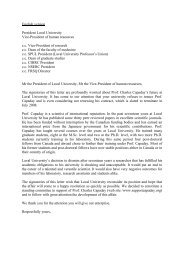Untitled - Laboratory of Neurophysics and Physiology
Untitled - Laboratory of Neurophysics and Physiology
Untitled - Laboratory of Neurophysics and Physiology
You also want an ePaper? Increase the reach of your titles
YUMPU automatically turns print PDFs into web optimized ePapers that Google loves.
internally generated propagating waves provide a specific structure for the spatiotemporal activity in<br />
visual cortex, uniquely encoding both stimulus identity <strong>and</strong> time <strong>of</strong> presentation in the amplitude <strong>and</strong><br />
phase <strong>of</strong> the population response [8]. With these results in mind, we go on to discuss the computational<br />
paradigms towards which our observations point, elucidating these with numerical models <strong>and</strong><br />
further analysis.<br />
Acknowledgements<br />
Work supported by the CNRS <strong>and</strong> the European Community (BrainScales project, FP7-269921). LM is a PhD<br />
fellow from Ècole des Neurosciences de Paris (ENP).<br />
References<br />
1. Xu W, Huang X, Takagaki K, Wu JY: Compression <strong>and</strong> reflection <strong>of</strong> visually evoked cortical waves.<br />
Neuron 2007, 55:119-129.<br />
2. Han F, Caporale N, Dan Y: Reverberation <strong>of</strong> recent visual experience in spontaneous cortical waves.<br />
Neuron 2008, 60:321-327.<br />
3. Ray S, Maunsell JH: Network rhythms influence the relationship between spike-triggered local field<br />
potential <strong>and</strong> functional connectivity. J Neurosci 2011, 31:12674-12682.<br />
4. Nauhaus I, Busse L, Ringrach DL, Car<strong>and</strong>ini M: Robustness <strong>of</strong> traveling waves in ongoing activity <strong>of</strong><br />
visual cortex. J Neurosci 2012, 32:3088-3094.<br />
5. Reynaud A, Takerkart S, Masson GS, Chavane F: Linear model decomposition for voltage-sensitive<br />
dye imaging signals: Application in awake behaving monkey. Neuroimage 2011, 54:1196-1210.<br />
6. Jancke D, Chavane F, Naaman S, Grinvald A: Imaging cortical correlates <strong>of</strong> illusion in early visual<br />
cortex. Nature 2004, 428:423-426.<br />
7. Reynaud A, Masson GS, Chavane F: Dynamics <strong>of</strong> local input normalization result from balanced<br />
short- <strong>and</strong> long-range intracortical interactions in area V1. J Neurosci 2012, 32:12558-12569.<br />
8. Ermentrout GB, Kleinfeld D: Traveling electrical waves in cortex: insights from phase dynamics <strong>and</strong><br />
speculation on a computational role. Neuron 2001, 29:33-44.<br />
O9<br />
Non-renewal spiking <strong>and</strong> neural dynamics – A simple theory <strong>of</strong> interspike interval<br />
correlations in adapting neurons<br />
Tilo Schwalger 1,2⋆ , Benjamin Lindner 1,2<br />
1 Department <strong>of</strong> Physics, Humboldt-Universität zu Berlin, Berlin, 12489, Germany<br />
2 Bernstein Center for Computational Neuroscience, Berlin, 10115, Germany<br />
There is accumulating evidence that the spiking <strong>of</strong> many neurons is not a renewal process but is<br />
characterized by correlations between interspike intervals (ISIs) [1]. These correlations are crucial for<br />
underst<strong>and</strong>ing signal processing in single neurons, however, their origin <strong>and</strong> structure is still poorly<br />
understood theoretically. Here, we present a simple theory <strong>of</strong> correlations in neural oscillators with<br />
spike-triggered adaptation currents, which are a major source <strong>of</strong> non-renewal spiking. These currents<br />
mediate spike-frequency adaptation <strong>and</strong> are commonly believed to result in negative correlations between<br />
adjacent ISIs. For such adapting neurons, we show that the serial correlation coefficient (SCC)<br />
is fundamentally related to the neuron’s phase response curve (PRC). The relation predicts possible<br />
correlation patterns that characterize how correlations depend on the lag between ISIs. Different patterns<br />
arise from the specific interplay between nonlinear neural dynamics <strong>and</strong> adaptation dynamics. In<br />
particular, the correlation structure can be determined by a single parameter that includes the shape<br />
<strong>of</strong> the PRC as well as the strength <strong>and</strong> time scale <strong>of</strong> the adaptation current (Fig. 1).<br />
For a positive PRC (type I), the SCC is always negative at lag 1. At higher lags, we find either a<br />
63



